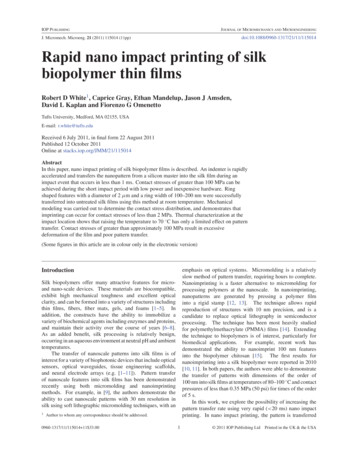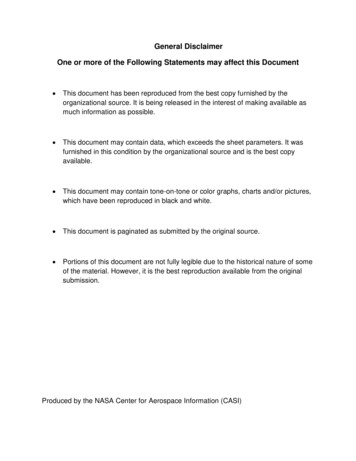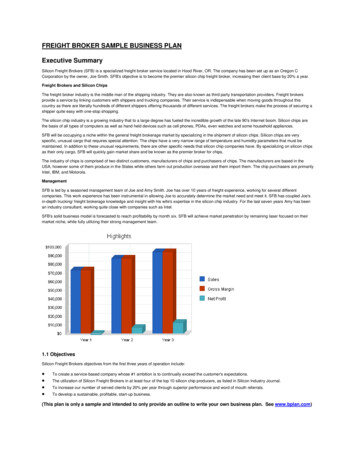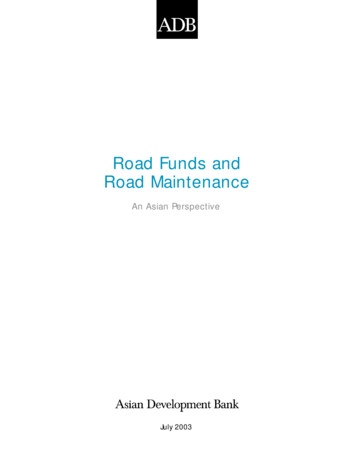Transcription
FROM SILK ROADTO SILICON ROADHOW THE BELT AND ROADINITIATIVE WILL TRANSFORMTHE GLOBAL ECONOMY
ForewordI am delighted that the Chartered Institute of Building is sponsoring thisreport examining the impact of the Chinese Belt and Road Initiative on theworld economy. It is a timely reminder of how the infrastructure needed tosecure international trade can contribute to a more prosperous future formany nations and help to build important relations globally.The Belt and Road Initiative is the most ambitious and largest infrastructureproject arguably in history and will eventually touch more than two-thirds ofthe world’s population across some 65 or more countries. Its impact andeffect will be felt for generations.The Chinese Belt and Road project includes a raft of investments beyondtraditional transport links - it will, of course, include road, rail and portinfrastructure but also energy, special development zones and urbantransport systems. In the longer term, it will almost certainly become moreelectronic than physical as roads are upgraded for autonomous vehicles andas digital infrastructure becomes part of the system.A key finding from this report is that Belt and Road will boost world GDP byUS 7.1 trillion per annum by 2040. This raises world GDP by 4.2% of likelyGDP in 2040 or by 8.3% from 2019 world GDP.The construction sector will also be boosted significantly over the next 15years by spending on Belt and Road projects - from US 11.5 trillion today toUS 29.4 trillion or 16.6% of world GDP by 2033.Some countries and regions will be boosted economically more than others.China and the US will benefit from the impact felt on world trade from Beltand Road because of their sheer size. Other countries that will be boostedinclude Russia, Japan, Indonesia, Korea, the UK, India and the Netherlands.Successfully building such a vast network of interconnected infrastructurerequires the experience, skills and in-depth understanding of themanagement of construction that are held by members of the CharteredInstitute of Building. I hope that among the many other outcomes from thisenormous undertaking that the 45,000 members of the CIOB, based in morethan 100 countries around the world, can contribute their professionalismand knowledge towards the management of Belt and Road projects.Chris SoffePresidentThe Chartered Institute of Building.World Economic League Table 2019
Global SponsorThe Chartered Institute of Building is at the heart of a management career in construction.We are the world’s largest and most influential professional body for constructionmanagement and leadership.We have a Royal Charter to promote the science and practice of building and constructionfor the benefit of society, and we’ve been doing that since 1834. Our members workworldwide in the development, conservation and improvement of the built environment.We accredit university degrees, educational courses and training. Our professional andvocational qualifications are a mark of the highest levels of competence andprofessionalism, providing assurance to clients and other professionals procuring builtassets.www.ciob.orgDisclaimerWhilst every effort has been made to ensure the accuracy of the material in this document, neither Centre for Economics andBusiness Research Ltd nor the report’s authors will be liable for any loss or damages incurred through the use of the report.Authorship and acknowledgementsThis report has been produced by Cebr, an independent economics and business research consultancy established in 1992. Theviews expressed herein are those of the authors only and are based upon independent research by them. The report has beenprepared by Cebr’s Macroeconomics team with support from Cebr’s Trade, Transport and Energy teams. Economists who haveworked on the project include Douglas McWilliams, Pablo Shah, Kay Neufeld, Michael McWilliams, Ian Birch and CristianNiculescu-Marcu. Many thanks to others in the Cebr team and to Graham Robinson of Global Construction Perspectives for alltheir help.The report does not necessarily reflect the views of the Chartered Institute of Building. London, May 2019World Economic League Table 2019
3ContentsSummary5The World’s Largest Infrastructure Project6Introduction6What we have compared7BRI and geopolitics8Who is impacted?9The global construction market11The risks11Conclusions12Regional Forecasts13Country 22.10 Korea232.11 Kyrgyzstan242.12 Malaysia252.13 Mongolia26World Economic League Table Belt and Road Initiative Special Study 2019
42.14 Netherlands272.15 Pakistan282.16 Russia302.17 Sweden312.18 Tajikistan322.19 Turkey332.20 Turkmenistan342.21 United Kingdom352.22 United States362.23 Uzbekistan37Risk Case38Appendix: notes on method39World Economic League Table Belt and Road Initiative Special Study 2019
SummaryThe study looks at the impact of the Belt and Road Initiative (BRI). The study uses Cebr’s economicimpact of transport and infrastructure analysis and Cebr’s trade frictions analysis.Although currently the BRI has about 2 trillions of projects already on the drawing board, we believethat as it succeeds it will expand to encompass many other projects. Ultimately over the next quartercentury we expect it to involve as much as 8 trillion of spend.We estimate that the Belt and Road Initiative is likely to boost world GDP by 2040 by 7.1 trillions perannum. This raises world GDP by 4.2% of likely GDP in 2040 (or 8.3% of GDP in 2019).The benefits of the BRI are widespread. As many as 56 different countries are forecast to have theirannual GDP in 2040 boosted by more than 10 billion as a result of the project.Other than China, which by 2040 will be by far the world’s largest economy and which will thereforebenefit from any boost to the world economy, the biggest single potential beneficiary of the BRI is(surprisingly) likely to be the US, even though it isn’t participating directly in the project. This is becauseof the sheer size of the US economy which means that it gains from the indirect effects of world GDPbeing boosted. Even though the boost to US GDP is only 1.4% (much smaller than most other majoreconomies) the absolute size of the US economy is still such that this is more than the absolute boost toany other economy except China. The next largest impact is in Russia, followed by Japan, Indonesia,Korea, UK, India and the Netherlands.The region of the world that will most be transformed by the BRI is likely to be Central Asia and Russiawhere we predict that GDP in 2040 will be 18% higher. GDP is also likely to be boosted in CentralEurope (6%) Western Europe (5%) and East Asia (5%).The largest proportional impacts are in Mongolia, the Kyrghiz Republic and Russia.Through the Belt and Road Initiative China will be continuing to drive world economic growth but in adifferent way from in the past. In the 10 years since the financial crisis in the West, China (now 15% ofthe world economy) has driven world demand by accounting for 40% of world GDP growth. Nowlooking forward China will be driving world GDP growth though helping the building of infrastructurethroughout the world and through reducing both transport and other frictions that hold back worldtrade.The study also considers the impact that might emerge if the BRI is delayed for any reason such as aworld economic slowdown or because of technical difficulties. If the spend is reduced by 1 trillion forexample, world GDP (compared with the 2 trillion spend base case) will be reduced by 0.9 trillion or0.5%. The region most affected will be Central Asia where GDP would be reduced by 5.9%.A key conclusion of the report is that as the BRI develops, it is likely to attract in further countries.Indeed it is highly likely that Western Europe, which has largely stayed aloof so far, will join in as theproject develops momentum. It is even possible, though clearly unlikely under the currentadministration, that the US will also get involved in the BRI. But this is a longer term aspiration.World Economic League Table 2019
6The World’s Largest Infrastructure ProjectIntroductionA vital part of the Roman Empire was its transport links. Over the period 450 BC to 150 AD the Romansbuilt 382 great roads over their Empire1. The length of the road network built by the Romans isestimated to have stretched to 400,000 km of which 80,000 km were paved2.There has been no systematic attempt to build a complete network of interconnected infrastructurescovering ranges of countries since then until now although of course there have been plans linking smallnumbers of countries.The earliest Roman road was the Via Appia which was started (and finished) in 312 BCE. The first partjoined Rome with Capua and was considered critical in enabling the Romans to subdue the Etruscans andthe Samnites. The road was extended to Brindisium (modern day Brindisi) in 264 BCE.Eventually the network of 382 major roads was completed connecting Britain to Africa and the MiddleEast and connected with the Persian Royal Road. The network is estimated to make up 400,000 km ofroads although only 80,000 km were paved.The Roman road network was largely completed before the Christian era, though some more were builtin the 1st century AD. We have not made an estimate to cost the Roman road network but at today’sprices a km of non-motorway road costs at least 5 - 10 million so the network of 80,000 km of pavedroads might have cost up to 800 billion were it built today.The Chinese Belt and Road project extends far beyond road infrastructure. It includes rail, energy, specialdevelopment zones and urban transport systems. Eventually it will almost certainly become moreelectronic than purely physical as roads are upgraded for autonomous vehicles and as digitalinfrastructure becomes part of the system. The projects identified so far will cost about 2 trillion butmany more will follow.The road parts of the project have been estimated to comprise 60,000 km of new or upgraded roads bythe Mercator Institute for China Studies in Berlin. So the road part is actually smaller than the Romanroad system.But the most impressive aspect of the BRI is the combination of global reach and the speed with which itwill come into effect. Most of the BRI system will be in place by 2040, implying a speed of building morethan ten times faster than the Romans.More interesting than the differences between the two systems are the similarities. The key point of theBRI is not just the physical and electronic infrastructure but the extent to which it makes trade aroundthe world easier. The Roman roads were initially built for military reasons but eventually mainly existedto support and enhance trade.Because the BRI is so critical to the world economy, it is important to understand how is likely to affectthis economy and where.12Duducu, Jem (2015). The Romans in 100 Facts. GL5 4EP UK: Amberley Publishing.Michael Grant, History of Rome (New York: Charles Scribner, 1978), 264World Economic League Table Belt and Road Initiative Special Study 2019
7We have used two techniques to estimate this impact. The first is to use Cebr’s techniques for estimatinghow improved infrastructure boosts productivity3. The second is work developed using agent basedmodelling by Cebr to show how trade frictions affect trade and how reducing them can lead tosubstantial benefits to the world economy4. We have then fed the microeconomic results into Cebr’sWorld Economic League Table Macroeconomic Model to derive the results for the global impact of theBRI on the world economy.What we have comparedThe Belt and Road Initiative (BRI) involves infrastructure development and investments and otherpotential changes including special economic zones and reduced customs formalities in 152 countriesand international organizations in Asia, Europe, Africa, the Middle East, and the Americas5. "Belt" refersto the routes for road and rail transportation, called "the Silk Road Economic Belt"; whereas "road" refersto the sea routes, or the 21st Century Maritime Silk Road6.Map of some of the currently planned parts of the Belt and Road Initiative. Image World Bank3These techniques are best described in the project reports of two European Commission Funded studies ASTRA and UPTUN.The ASTRA project is written up in http://www.astra-model.eu/doc/ASTRA-model.pdf. The key data is on pages 28-41. TheUPTUN project is written up in the Proceedings of the Institution of Civil Engineers - Structures and Buildings ISSN 09650911 E-ISSN 1751-7702 These techniques are best described in the project reports of two European Commission Fundedstudies ASTRA and UPTUN. The ASTRA project is written up in http://www.astra-model.eu/doc/ASTRA-model.pdf. The key datais on pages 28-41. The evaluation module of the UPTUN project is written up in the Proceedings of the Institution of CivilEngineers - Structures and Buildings ISSN 0965-0911 E-ISSN 1751-7702 Volume 162 Issue 3, June 2009, pp. 183-197 ‘Newmethods for road tunnel fire safety evaluation and upgrading’ G. A. Khoury, MSc, PhD, DIC, EurIng, CEng, FIStructE, MINucE,MIFireE, FRAeS, D. Walley, MA, and D. McWilliams, MPhil, MA4This work is described in a report by Shanker Singham and Cristian Niculsescu-Marcu of Cebr not-be-seen-as-separate/5 Belt and Road Initiative". World Bank.6 Kuo, Lily; Kommenda, Niko. "What is China's Belt and Road Initiative?". the Guardian. 2018-09-05World Economic League Table Belt and Road Initiative Special Study 2019
8We have carried out a rigorous investigation of those BRI projects that have reached drawing boardstage and identified 215 projects so far of varying size and importance. Our Energy and Transport teamshave made a rough costing of these and they amount to a potential spending of about 2 trillion.Clearly this is just the tip of the iceberg.Our engineers have also looked at the discussions surrounding the BRI and have identified a wide rangeof additional projects that seem likely to link with the BRI:Additional BRI areas are likely to include: A 5G global fibre network with global satellite coverA global energy interconnector. See Geidco.org for many more detailsDevelopment of the Arctic Belt and Road where the Russian and Chinese initiatives will probablymerge. Nordic and other countries will become involved.The Western European end of the Belt and Road - at present, other than Greece and the recentaccession of Italy, Western Europe has stayed aloof. This is likely to change as the success of theBelt and Road initiative becomes more apparent - we believe it is highly likely that much of therest of Europe will get involved including the UK, the Netherlands, Germany and France inparticular. Also some more central European countries like Poland.The autonomous vehicle Belt and Road - upgrading of the highways links to cater forautonomous vehiclesThe hyperloop Belt and Road - a worldwide network of hyperloop linksThe green belt and road - a worldwide network of renewable energy sources and (mostimportantly) storageThe Pacific and Latin American Belts and Roads which will be improved transport and portsfacilities including the tunnel through the AndesAn academic Belt and Road initiative that links universities and scientific research with potentiallong term impacts on technology and productivity.We have provisionally allocated 8 trillions of spend by 2040 on this for our evaluation. We havecompared this with the base case which is the 2 trillions of spend already on the drawing board.We have also looked at the implications if for various reasons the Belt and Road Initiative has to bescaled back or slowed down. This might happen if, for example, a global economic crisis reduced theappetite for taking on debt or if the technological difficulties of such an extensive and path breaking setof projects turn out to be greater than anticipated. Our risk case assumes that the base case 2 trillionspend by 2040 is cut back to a spend of only 1 trillion. It is worth noting that even that level of spendingwould be greater than our estimate of the cost of building the 80,000 km of paved Roman Roads attoday’s costs.BRI and geopoliticsThe Belt and Road initiative has emerged at an interesting time for the world economy. Since 1890 theUS has been the world’s largest economy and indeed in the middle of the 20th century, with much of therest of the developed world ravaged by war, US GDP reached an astonishing 50% of world GDP on somemeasures.World Economic League Table Belt and Road Initiative Special Study 2019
9But, according to the latest Cebr World Economic League Table, in 2032 China will overtake the US tobecome the world’s largest economy again. History tells us that such shifts in economic power do notoccur without tensions. Moreover, as the Western world gradually diminishes in relative economicpower, it is likely that a third mega power, India, with a population 50% larger than China’s by then willalso be amongst the leaders by the end of the 21st century.Some critics see the BRI as an attempt by China to extend its influence and soft power. Cebr’s view isthat it is not surprising that a major world economy should wish to help encourage the rest of the worldto develop. Since our calculations suggest that the impact is positive for world GDP we see it as a win winfor the other world economies. We also see the BRI as a welcome antidote to the impact of the tradetensions currently surrounding the world economy.We expect those parts of the world that are currently less enthusiastic about the BRI to become more soas it starts to show its benefits. We attach a high probability to Western Europe joining in much moreclosely than hitherto and it seems possible (though clearly not under the current Trump administration)that if some rapprochement between the US and China takes place that the US will also eventually join inwith the initiative.Who is impacted?We have estimated the impact on World GDP in 2040.The Full Belt and Road is likely to boost world GDP by 2040 by 7.1 trillions per annum. This raises worldGDP by 4.2% of likely GDP in 2040 (or 8.3% of GDP in 2019). In other words world GDP growth betweennow and 2040 is predicted to be boosted by 0.2% per annum. This is a massive increase and reflects notonly the scale of the infrastructure but its particularly significant impact in boosting trade and leveragingthe potential gains from trade around the world. We are assuming that the effects of the improvedinfrastructure are matched proportionately by other measures to facilitate trade including improvedborder procedures in addition to the Special Economic Development Zones that are already part of theBRI Project.The key results of the study are set out in Table 1. It isn’t surprising that China, sponsor of the project, isthe biggest beneficiary. What is much more surprising, given the opposition to BRI from the current USadministration, is that the second largest beneficiary in absolute terms is the US! This is because the USis such an important part of the world economy that it is impossible to boost the world economy withoutit impacting on the US through its impact on US exports and through its multiplier effects.World Economic League Table Belt and Road Initiative Special Study 2019
10Table 1 Top 50 countries gaining most in absolute terms from the BRIGains by country from the BRI in 2040 billions annual rateChinaUnited StatesRussiaJapanIndonesiaKoreaUnited denSingaporeFrancePolandArgentinaIslamic Republic of IranCanadaNew anCzech RepublicPapua New GuineaKenyaSaudi ArabiaPhilippinesNorwayHungarySwitzerlandUnited Arab EmiratesEast AsiaNorth AmericaCentral AsiaEast AsiaEast AsiaEast AsiaWestern Europe and ScandinaviaSouth AsiaWestern Europe and ScandinaviaSouth AsiaPacificCentral and Eastern EuropeWestern Europe and ScandinaviaEast AsiaLatin America and the CaribbeanWestern Europe and ScandinaviaWestern Europe and ScandinaviaEast AsiaWestern Europe and ScandinaviaLatin America and the CaribbeanWestern Europe and ScandinaviaEast AsiaWestern Europe and ScandinaviaCentral and Eastern EuropeLatin America and the CaribbeanMiddle East and North AfricaNorth AmericaPacificEast AsiaEast AsiaSub-Saharan AfricaCentral and Eastern EuropeSouth AsiaLatin America and the CaribbeanCentral and Eastern EuropeLatin America and the CaribbeanCentral AsiaEast AsiaEast AsiaCentral and Eastern EuropeEast AsiaCentral and Eastern EuropePacificSub-Saharan AfricaMiddle East and North AfricaEast AsiaWestern Europe and ScandinaviaCentral and Eastern EuropeWestern Europe and ScandinaviaMiddle East and North 161615151513131212Other major beneficiaries are Russia, Japan, Indonesia, Korea, the UK, India and the Netherlands. But wehave calculated that 56 countries will have their GDP boosted by more than 10 billion by 2040 as aresult of the initiative.World Economic League Table Belt and Road Initiative Special Study 2019
11Table 2 Countries with biggest percentage impact on economy from BRIBRI Impact on GDP in 2040 %MongoliaKyrgyz ited Arab .5%12.1%11.4%10.8%10.6%10.5%In some ways more interesting are the countries that are set to be transformed in percentage terms bythe Belt and Road Initiative. This is shown in Table 2.These are particularly Mongolia where opportunities for minerals extraction are opened up, the KyrgyzRepublic which is affected in a similar way to Mongolia and Russia which is potentially massively affectedby the new infrastructure, much of which in actual terms will be located there and which will become themajor conduit between East and West. Pakistan, which is one of the largest direct beneficiaries in termsof actual Belt and Road projects is also disproportionately affected.The global construction marketWe have estimated that global construction spending in 2018 was 11,448 billions which represented13.5% of global GDP. We have previously forecast that this share, which is already one of the highest onrecord other than at times of post-war recovery, is likely to edge upwards for a range of reasons.First, there is a wide range of mega projects underway starting with the Chinese Belt and Road initiative.These mega projects account for an increasing proportion of world GDP.Second, in many economies there is an infrastructure backlog. In the coming years this will need to bemade up so that planned GDP growth can take place.Third, new technologies will require new investment in a wide range of construction activities.Finally, with growth tailing off in the short term we are expecting governments around the world toboost growth with additional infrastructural spending.But with the additional Belt and Road spending that is likely to be necessary to achieve the 8 trillion BRIplan envisaged, there will be even more construction spending than we had previously envisaged.As a result we now project that construction spending will rise from 11.5 trillion to 29.4 trillion or16.6% of world GDP by 2033. Beyond that, it is likely that the electronics content of the BRI will risedisproportionately and so the construction share of World GDP is likely to stabilise or edge down.The risksThere are of course risks to this. There are the normal economic, political and military risks which alwayshave to be taken into account.World Economic League Table Belt and Road Initiative Special Study 2019
12But there are also risks that relate specifically to the projects themselves. They are at the cutting edge oftechnology and as a result who can tell what technological obstacles might emerge. Obviously there is anallowance for contingencies but who knows whether this will be sufficient.There are also economic obstacles. If the world economy develops more slowly than expected, there is arisk that either lenders or borrows might face debt obstacles which would constrain the pace ofspending.We have therefore evaluated a risk case where we have evaluated the impact of reducing the BRI spendby 1 trillion. The estimated impact of this is to reduce world GDP in 2040 by 0.5% or 0.9 trillion. Theregion most affected is Central Asia, where GDP is reduced by 5.9%.ConclusionsThese estimates are very tentative and of course are based on many assumptions. But what they show isthat the Belt and Road Initiative is of worldwide importance and its impact, if successful, will bewidespread.World Economic League Table Belt and Road Initiative Special Study 2019
13Regional ForecastsIt is interesting to see which regions of the world benefit most from the Belt and Road initiative. This isshown in Table 3.It is not surprising that the biggest single impact is in Central Asia. Until now this part of the world hasbeen hindered by its isolation and relative lack of population. But it seems clear that this is about tochange as the BRI infrastructure makes it much easier for the region to realise its potential. Some of thisis likely to involve minerals extraction, though this will clearly need to managed carefully from anenvironmental perspective.Central and Eastern Europe will also benefit, particularly Russia as is shown in the country forecasts.Table 3 Percentage Impact on GDP by region from BRI 2040South AsiaCentral and Eastern EuropeMiddle East and North AfricaSub-Saharan AfricaLatin America and the CaribbeanCentral AsiaPacificWestern Europe and ScandinaviaEast AsiaNorth ch of the Maritime Silk Road is projected to link with Sub Saharan Africa. Ultimately Africa could be amajor beneficiary as the BRI develops. But our analysis suggests that it would be premature to expect themajor benefits in the near future because the constraints on Africa’s development are likely to be inother areas. We do expect Africa to become a major beneficiary in the second half of this century.World Economic League Table Belt and Road Initiative Special Study 2019
14Country ForecastsAustraliaWith a GDP per capita of 52,360 in international dollars, Australia is a high income country, ranked 20thin the world when measured by GDP per capita based in Oceania.Of the current 215 BRI projects, the only project currently directly involving Australia is the proposedupgrading of Darwin Port (see Table 4). But Australia is likely to benefit from a range of new links throughPapua New Guinea and Indonesia that are likely to be developed. Australia’s Parliament has reportedthat ‘One Belt One Road provides a global context for China's growing economic links with Australia’. Atthis stage the Australian Federal Government has not formally signed up to the Initiative but the State ofVictoria signed up in 2018.Table 4 Australian BRI Projects Currently AnnouncedProjectDarwin portTypeTransportSpend Completion 10bn2025Because a third of Australia’s exports go to China, we think it inconceivable that the current policy ofstanding aloof from the BRI can persist and we expect that over the next 20 years Australia’s links withthe project will expand rapidly.The Australian economy is forecast to have the 11th largest boost from BRI by 2040. We estimate the netimpact will by 93 billion or 3.7% of GDPWorld Economic League Table Belt and Road Initiative Special Study 2019
15AzerbaijanAzerbaijan is a former Soviet republic in the South Caucasus. It borders the Caspian Sea to the east, Russiaand Georgia to the north, Armenia to the west and Iran to the south. Azerbaijan is an oil rich country witha per capita GDP of 17,950 in international dollars.Azerbaijan is close to many of the areas where the Belt and Road initiative is likely to develop and althoughis currently only part of two major BRI projects we think it highly likely that this number will grow. TheAzeri government is a full participant in the BRI and President Aliev’s visit to Beijing in April 2019 yielded10 agreements to develop projects in conjunction with China. The BRI projects that currently involveAzerbaijan are set out in Table 5.Table 5 Azeri BRI Projects Currently AnnouncedProjectBaku Tbilisi railTrans Anatolian Natural Gas PipelineTypeTransportEnergyCost Completion 5 bnOpen 5 bn2035We estimate that the BRI will boost Azeri GRP in 2040 by 4.6 billion or 6.8% of GDP.World Economic League Table Belt and Road Initiative Special Study 2019
16BrazilBrazil is a country in South America with a GDP per capita of 16,110 in international dollars. Despite thesevere recession which saw Brazil’s economy contract by nearly 8% over 2015 and 2016, the countryremains the largest economy in South America. However, a weakening of the Brazilian real against the USdollar has pushed Brazil down from 8th in the World Economic League Table in 2017 to 9th in 2018, as Italyovertook. The service sector accounts for 73% of Brazil’s GDP. Brazil is also one of the most competitiveagricultural exporters in the world as well as being heavily industrialised.Despite Brazil being one of the largest economies in the world, it has not so far had any projects that areentirely part of the BRI. Nevertheless, two projects, the ultra extra high voltage system to transportenergy from the Belo Monte Dam to Southeast Brazil, and the São Luís Port, in the northeast region arealready linked to the BRI.China is Brazil’s largest trading partner – Brazilian exports to China rose to over 100 billion in 2018. It islikely that as the BRI develops a
FROM SILK ROAD TO SILICON ROAD. World Economic League Table 2019 Foreword I am delighted that the Chartered Institute of Building is sponsoring this report examining the impact of the Chinese Belt and Road Initiative on the world economy. It







